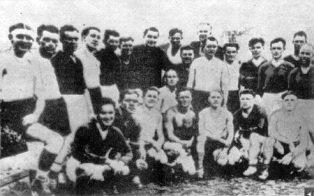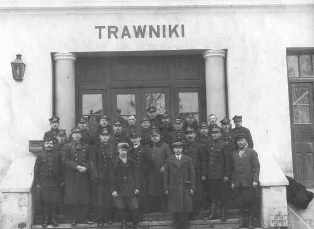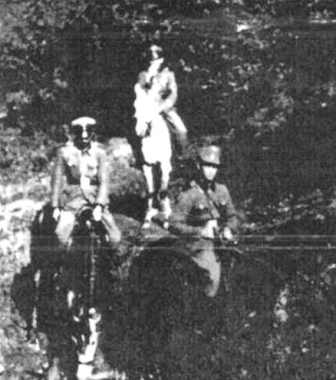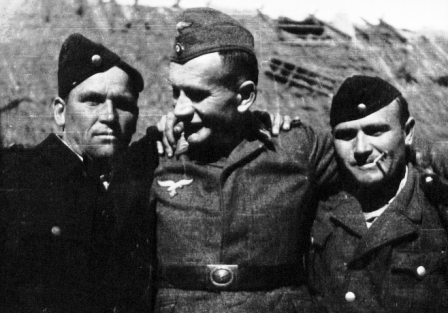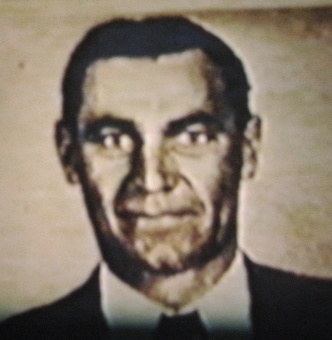From Record of Interrogation of Defendant Korotkikh City of Voroshilovgrad 21 April 1950 (Selected Extracts) [photos added to enhance the text] 1. I, Senior Lieutenant YEVSTIGNEYEV, Senior Investigator of the Ministry of State Security of the Ukraine, Voroshilovgrad Region, have interrogated on this day
KOROTKIKH, Dmitriy Nikolayevich,born in 1912, native of the village of Khlevnoye, Khlevnenskiy district, Vorenezh Region, Russian, citizen of the USSR. |
The interrogation started at 11.20am.
Having surrendered as prisoner to the Germans, I was held for some six days in the prisoners of war camp in the town of Belaya Tserkov, from where the Germans took me together with a large number of war prisoners by train to the prisoners of war camp at Chelm (Poland), where we were kept for about two months without occupation.
Subsequently, again with other prisoners, I was taken, as I found out later, to the SS training camp of the village of Trawniki (Poland) where I remained from November 1941 to the spring of 1942 and was trained to be a guard (wachman).
Question: Under what circumstances did you happen to find yourself in the SS training camp?
Answer: While I was in the Chelm camp, four German officers in SS uniforms came to the camp, aligned the prisoners and began to pick out the physically healthy ones. I happened to be among the war prisoners, numbering about 80, who were thus selected.
That same day we were loaded into cars and taken to the SS training camp at Trawniki.
Question: Did the German officers tell you where to and for what purpose they were recruiting war prisoners?
Answer: No, while they picked out war prisoners, the German officers did not tell us where to and for what purpose they were doing so. It was only after my arrival at Trawniki that I learned that war prisoners were being selected to be trained in the police training camp of the SS.
Question: What was the SS training camp in the little town of Trawniki really like?
Answer: The SS training camp in which I was trained was situated at the edge of the little town of Trawniki, on the territory of a factory, in a few large, brick one-storied building. The German Kommandantura was also housed there in a two-storied building.
The SS training camp or the school for guards as it was called, prepared trained policemen for guard and convoy duty in the SS troops and to exterminate prisoners held in concentration camps.
The training period in the SS school for guards was indefinite, it depended on the need for guards. These were taken from the camp regardless of their state of preparedness, but the training period was roughly of about six months.
During our stay in the SS guards school, we underwent drilling and shooting training. We studied weapons – the rifle, also the rules of sentry duty. We learned German songs and took special training in sentry and convoy duty, learned the rules for the guarding and convoying of prisoners.
In the spring of 1942, I do not recall the month, after completing the SS school for guards, together with a group of selected guards comprising some 30 men whom Fedorenko, Krivenko, Prisch, Dudniko and others of the Trawniki school.
I was sent to the city of Lublin (Poland) to guard a concentration camp situated at the edge of the city of Lublin. As I learned later, individuals of Jewish nationality had been held there, but by the time of our arrival, they had been taken away, where to I do not know, and there were no prisoners left in the camp.
We stayed there for about four days without occupation, then we were taken back to the camp in Trawniki where I stayed until the fall of 1942 and underwent training.
After this I was sent to the little town of Treblinka, where there was a camp especially destined for the mass extermination of Jews and which was called the “death camp.”
After my arrival at the little town of Treblinka, I was put into an SS sentry team. I served in this camp until November 1943 that is until the liquidation of the Treblinka camp.
Question: What was the Treblinka camp really like?
Answer: The Treblinka camp in which I served as a guard was a “death camp.”
Mass extermination of Jews in special gas chambers took place in this camp. It was situated in a forest. A highway passed about half a kilometre from it, and the village of Wulka was located some two kilometres away.
The entire territory of the camp was fenced in with barbed wire camouflaged with interwoven branches. Iron anti-tank obstacles intertwined with barbed wire were placed around the camp some fifty meters from the barbed wire, thus making it impossible to approach the camp.
Four watchtowers manned by sentries from among the guards stood between the barbed wire barriers and the anti-tank obstacles.
The camp had two gates, through one passed the railroad branch coming from Treblinka station and on which trains bringing in the doomed prisoners arrived. The second gate served to bring in supplies and adjacent to it stood a sentry box. All these entrances were also guarded by the wachman guards.
At the entrance to the camp, to the right, stood the barrack in which the Germans numbering some 50 persons were housed. These and the entire exterminating enterprise were under the command of the camp Commander Untersturmfuhrer Franz.
At the entrance to the camp, to the left, stood a building in which was located the German headquarters of the camp. Four barracks situated behind the headquarters served as quarters of the guards.
The barber shop and the dining room in which the guards and the Germans who serviced the camp ate, were located in the same building. The territory of these barracks and the headquarters were fenced off with barbed wire from the main area of the camp.
Beyond the fence, on the left, in two large barracks, was quartered the so-called “working crew” numbering some 200 people of Jewish nationality, selected by the Germans from among the people to be exterminated.
Beyond the barracks, near the railroad, there were two more barracks intended for the initial stay of people unloaded from the trains and they served at the same time as “undressing places.”
Both were fenced in with one row of barbed wire. From the undressing place, a narrow passage made of barbed wire led to the gas chambers building, or as it was called, “the bath-house.”
At the end of the camp there stood a barrack which served as storage place for the belongings of the exterminated prisoners. Behind the gas chambers building there were large pits into which the people killed were dumped and then burned in special incinerators.
Until about the summer of 1943 there was only one gas chambers building with three gas chambers, but later, because of the insufficient capacity of the building, another one with six chambers was built alongside the first.
While filling the chambers with prisoners, the Germans beat them up with whips to force them to press together closer and thus make it possible for more people to be crowded inside the gas chambers.
The filled-up rooms were immediately hermetically closed, the people inside died. Some 20 – 30 minutes later the doors were opened and the “working crew” consisting of Jews immediately started to unload the bodies from the chambers.
In November 1943, in connection with the liquidation of the Treblinka camp, I was assigned to the city of Stutthof where until the end of the summer or the beginning of the fall of 1944 I served as guard of a concentration camp.
I guarded a camp in which war prisoners of Russian, Polish and other nationalities were held. I escorted the prisoners to work and from work to the camp. Together with a group of some 20 – 30 guards, I was sent to the village of Pelets, where I also served as guard.
About February – March 1945, as the Soviet Army units were approaching, I was transferred to the village of Novogasm where I was a reserve guard at the concentration camp, then some 10 days later the Germans tried to evacuate us to Denmark, but in May 1945 I was taken by the English troops in the city of Hamburg.
Question: Name the individuals known to you from among the command personnel of the SS units in which you had to serve?
Answer: The following are known to me from among the command personnel of the SS troops:
1.ROYDER, I do not know his name or patronymic, 50 years old, of German nationality, was deputy commander of the concentration camp of the city of Stuthof, had the rank of Hauptsturmfuhrer. Distinctive features – blond, average height, thickset, straight thin nose.
2. HOPPE, I do not remember his first name, 45 years old, of German nationality. In 1944 was commander of the concentration camp of the city of Stutthof, had the rank of Sturmbannfuhrer. The camp contained several thousand prisoners of war of Russian, Polish and other nationalities who were used to build factories in the city of Stutthof.
3. FRANZ – Untersturmfuhrer about 40 years old, of German nationality. In 1942 -1943 was commander of death camp in Treblinka (Poland). In charge of all measures to exterminate individuals of Jewish nationality in the gas chambers. Several thousand people were exterminated there during the period of my service in this camp from 1942 to 1943. Distinctive features above average height, thickset, round face.
Due to the time elapsed I cannot remember the names of other persons in the command personnel of the SS troops.
Question: Name all guards you knew, who took part in the mass extermination of citizens of Jewish nationality in the Treblinka death camp?
Answer: Among the individuals who served with me in the SS troops and took part in the mass exterminations of citizens of Jewish nationality in the Treblinka death camp I know:
1. FEDORENKO, I do not remember his first name and patronymic, born about 1910, I do not know the place of his birth, or that of his residence. During the Patriotic War he served in the Soviet Army, but how he became a prisoner of the Germans I do not know. I first made his acquaintance in the school for SS guards in Trawniki in the fall of 1941.
In the spring of 1942, I do not remember the month, he was sent together with me to the city of Lublin (Poland) to guard a concentration camp, but some four days later we returned to the Trawniki camp where we remained until the fall of 1942 and were trained in the school for SS guards.
After this, together with me and other guards he was transferred to the Treblinka “death camp.” In this camp he served as sentry guarding the camp to prevent doomed prisoners from escaping, guarded the passage extending from the undressing area to the gas chambers, stood in the cordon of guards to prevent individuals sent to the gas chambers from escaping through the barbed wire, conveyed to work the Jews belonging to the working crew who cut down branches in the forest to fence in and camouflage the camp.
He participated in the unloading of the trains that arrived with individuals of Jewish nationality who were then sent to the gas chambers to be killed.
In November 1943, the Treblinka camp being liquidated, he was assigned to the city of Stutthof where he guarded a concentration camp for Russian and Polish war prisoners.
In the summer of 1944 I left the camp and did not meet him again. I do not know where he is now.
Distinctive features: Dark hair, above average height, elongated face, has two gold front teeth.
The interrogation was finished at 5.00pm.
The record of interrogation was read by me, the answers are written down correctly, to which I sign my name.
(Signature)
The interrogation was made by: Senior Investigator of the Investigating Department of the Ministry of State Security of the Ukraine, Voroshilovgrad Region.
Senior Lieutenant YEVSTIGNEYEV
The Excerpt is true:
First Deputy Procurator of the Crimean Region Senior Councillor of Justice KUPTSOV
29 March 1978
Notes by Author: Lublin Concentration Camp on the outskirts of the city of Lublin. The number of the gas chambers in Treblinka, in the larger gas chambers stated as six by Korotkith. Jewish survivors Wiernik and Rosenberg state the number of chambers were ten. The plan of the camp exhibited at the former camp commandant’s trial shows ten chambers. Stutthof’s commandant Hoppe’s, first name was Paul. Kurt Franz was only appointed commandant of Treblinka to complete the liquidation of the camp, once Stangl had been reassigned to Italy in September 1943. The exact number of Jews exterminated in Treblinka is impossible to determine.
Sources: Holocaust Historical Society Archives of Luhansk Region Copyright. Johannes Weber H.E.A.R.T 2010 |
